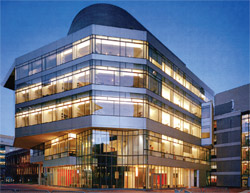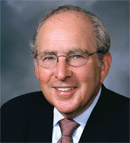Harvard School of Dental Medicine
Boston, Massachusetts
Interviewee:
R. Bruce Donoff, DMD, MD
Dean and Walter Guralnick Distinguished Professor of Oral and Maxillofacial Surgery
|
The Harvard Dental School, founded in 1867, was the first university-based dental school in the United States to be established in close affiliation with a medical school (Harvard Medical School), making the full scholarly and scientific resources of a university available to dental education.
In 1940, under President James B. Conant, the school was reorganized as the Harvard School of Dental Medicine to place stronger emphasis on the biological basis of oral medicine and to institute multidisciplinary programs of dental research. A unique feature of the curriculum placed dental students in joint classes with medical students for 2 years of basic science and pathophysiology, and for an introduction to clinical medicine on the wards of Harvard’s teaching hospitals. The philosophy that dentistry is a branch of medicine continues to this day.
In 1957, the School of Dental Medicine was awarded training grant funding from the National Institute of Dental Research and began to expand and enhance its postdoctoral educational programs, combining advanced clinical and biomedical research training for dentists planning careers in academic dentistry. Several new postdoctoral programs were developed, including a Doctor of Medical Sciences in oral biology; an oral and maxillofacial surgery/MD/general surgery program; and a group of 3- and 4-year joint-degree programs combining advanced clinical training and research in healthcare systems, health policy, or biomedical sciences. Since 1991, the school has reorganized its departments and introduced the first problem-based curriculum in clinical dentistry, developed a successful Faculty Dental Center, increased the class size to 35 students, created a PhD program in biological sciences in dental medicine, and constructed a new Research and Education Building.
Question No. 1
Inside Dentistry (ID): Exciting and innovative new research initiatives are taking place at dental schools nationwide. What is the most significant area of research at your school?
R. Bruce Donoff (RBD): Our most significant area of research is the integration of the molecular biology of bone, genetics, craniofacial biology, and dental medicine. Our new Research and Education Building has brought together scientists, clinicians, and students at all levels focusing on questions surrounding the bone–tooth interface, the genetics of bone biology, signal transduction, and the clinical translation of science. The place of genetics is most important because it informs not only basic questions in development, but also in areas such as epidemiology, molecular epidemiology, and dental disease ranging from periodontal disease to oral cancer to tissue engineering. As the tools of genetic analysis become less expensive, they will reveal new and exciting associations and diagnostic and preventative strategies for dealing with oral and craniofacial illness.
Question No. 2
ID: What endeavors have been most successful for you in terms of securing funding for this type of research or other types of translational research?
RBD: The single most important factor in securing funding is recruiting the best investigators who can compete in these difficult times. This carries with it the imperative of having the educational and research programs to educate and train this next generation of investigators. The National Institutes of Health is the most important source of funding for research. Investigators in the Faculty of Medicine both at the Medical School and at the affiliated hospitals hold major grants from the National Institute of Dental and Craniofacial Research. We have been fortunate even in these difficult funding times to increase our overall federal funding to almost $9 million over the past 3 years.
Question No. 3
ID: The demographics of dental schools overall—in terms of faculty composition and the student population—are changing. What changes have you seen at your school in particular?
RBD: This is a platinum time for the dental profession, but there is still cause for concern. More, and better qualified, students are applying for entrance, probably based both on the impact of managed care on medicine and the attractiveness of dentistry as a profession. The increase in women in dental school is wonderful, but we still have problems in increasing minority enrollments. It is an amazing time to consider innovation in education that could change the profession by taking advantage of new science and treatments, enhancing diversity, and improving access to care. Debt burden is career-shaping for students, so there is concern that an entire generation of academic leaders will divert to private practice because of remuneration issues. The same issue impacts the recruitment and retention of faculty.
Question No. 4
ID: How has your school responded to these changes, and what have the reactions been from students, faculty, and administrators?
RBD: We consider our mission and vision paramount to our strategies to deal with the changing environment. Our mission is “to develop and foster a community of global leaders to serve and advance oral and systemic health.” Our vision is “to set the standard of excellence in education, patient care and research in the field of dental medicine.” We have been fortunate to be successful in having graduates who have been leaders in every facet of the profession. Deans, executive directors, department heads, and caring, committed faculty comprise a disproportional number of our pre- and postdoctoral graduates given the size of our student enrollment.
We have a Dean’s Scholar program that supports committed students entering academia for 1 or 2 years as they become junior faculty members. The University’s Presidential Scholars program supports both pre- and postdoctoral trainees as well. To respond to salary differences between academicians and private practice clinicians, we began a Faculty Practice in 1993 that has grown to be an important source of revenue for faculty and the institution, and we created a center of excellence of dental care as well. This has let us increase our full-time faculty dramatically. This has been important as our class size increased to 35 when, in response to financial challenges for students, we introduced the innovative problem-based, case-based 4-year curriculum in 1994. It replaced a 5-year program that had been in place for 10 years. It maintained the best of the old, including hospital rotations and community center rotations.
The change to a 4-year curriculum was a tipping-point moment for the school in which the number of applications rose dramatically and all of the students enrolled have given the program high marks. Because our students are commingled with the medical students for the first 2 years, this was a seminal change for dental education.
Question No. 5
ID: There are many challenges and opportunities in oral healthcare. What do you see as the most urgent need, and how does your school differentiate itself in efforts to respond to those challenges and opportunities?
RBD: There are several major challenges and multiple opportunities for the dental profession. The impending shortage of dentists is one and faculty shortages make this more acute; the opening of new schools only intensifies this problem. Our school is dedicated to producing teachers and clinicians/scientists. We have a difficult record to maintain but we believe that with proper recruitment, mentoring, and support of students, we can succeed. We continue to have a research requirement for our predoctoral students and our graduate programs are longer than most because of our goal of producing clinical scholars. Admittedly, in the last few years new challenges to this goal have appeared and I have mentioned just a few of the programs instituted to deal with them. Secondly, issues of access to care for all segments of the population are a great concern. To that end we have fostered a strong department of epidemiology and public health dentistry, which has many community ties and involves all of our students in exposure to population concerns and solutions. Whether it is winning awards for programs like Project Bridge or running the dental service of the Cambridge Health Alliance Hospitals and clinics, our students and postdoctoral students are thoroughly knowledgeable about this issue and help to solve it.
We believe that dentistry is a branch of medicine and that knowledge of the whole body informs care of the oral and craniofacial complex. The day has come when more patients have chronic disease than ever before. When more patients are on medicines, it demands a greater knowledge of general medicine. The progress of science and technology is making medical as well as manipulative management a reality in the treatment of dental disease.
Question No. 6
ID: Is there anything else you would like readers to know about your school, or that you would like to comment on in general?
RBD: The Harvard School of Dental Medicine is a special place. It changed my own life and influences our students in so many ways. Flexibility and serendipity are possible within a rigorous curriculum that provides an environment of excellence that prepares students to pass all of the usual tests of competency and licensure. We are very fortunate to be part of a profession that is successful and respected, and we must not become complacent. Challenges will come from within the profession as well as from without. We must not be insular because that is when great dental schools like Northwestern, Washington University, Loyola of Chicago, and Georgetown close. To be different is not to be wrong. We should encourage all schools to maintain and improve basic biomedical education. I believe the next great challenge and opportunity for the profession is to honestly appraise the efficacy of an internship year. I am not opposed to examination for I truly believe one does not know what they know until they are asked. An internship year would enhance the repertoire and expertise of dental graduates under close supervision and truly provide better patient care and change a licensing system that is archaic in its use of live patients, misrepresented in its claims to be more than a driving test, and steeped in tradition and control rather than educational merit and fairness.
 |
| Harvard School of Dental Medicine's new Research and Education Building was dedicated in June 2005. |




